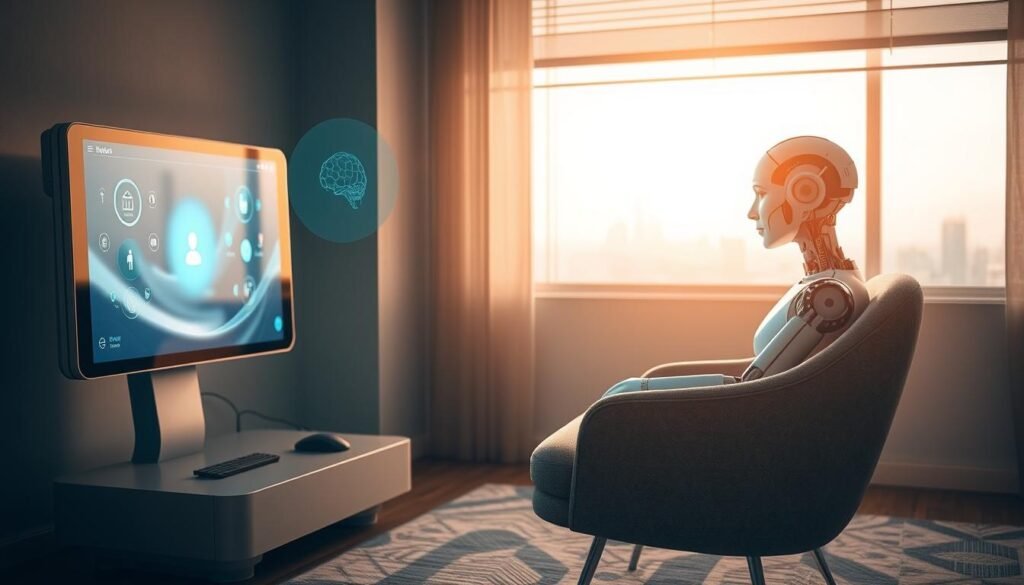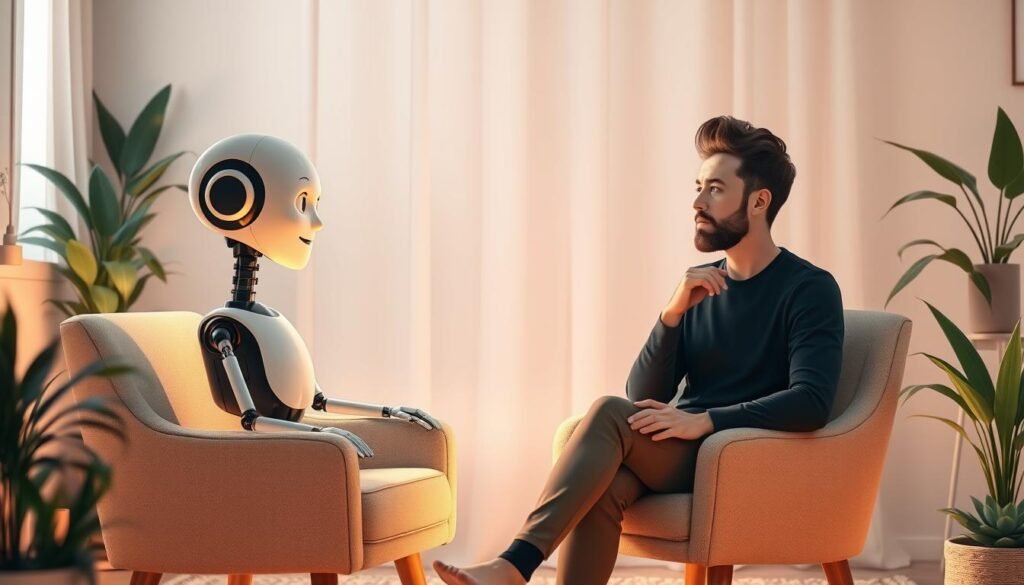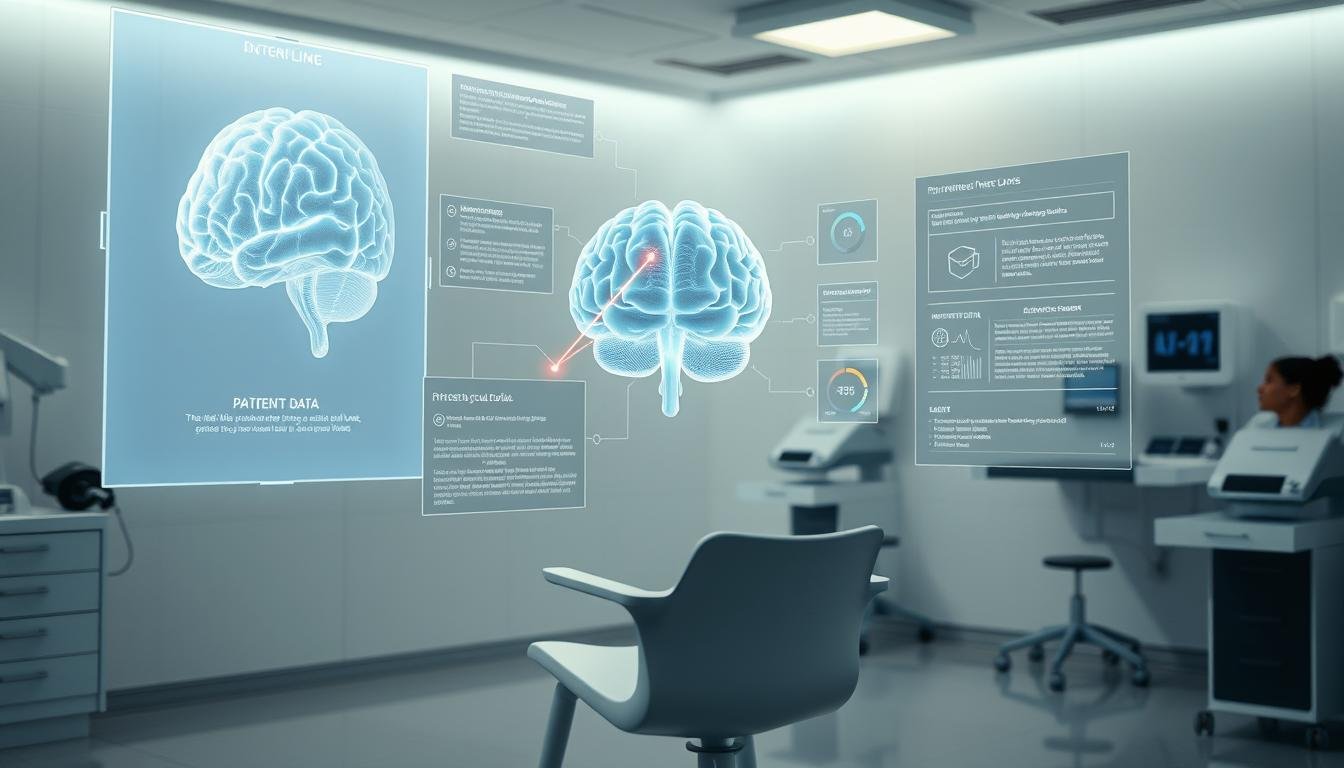Can AI Replace Human Therapists?
Did you know that over 60% of people using mental health services have interacted with a chatbot at least once? This surprising statistic highlights the growing role of technology in mental health care. But does this mean it can replace the human touch?
Recent advancements in artificial intelligence have introduced tools like Woebot and ChatGPT. These chatbots offer support and guidance, making mental health services more accessible. They provide immediate responses and can help with interventions like cognitive behavioral therapy.
However, experts like October Boyles and David D. Luxton argue that while technology is beneficial, it cannot fully replicate the empathy and emotional connection of a human therapist. The relationship between a patient and a professional is built on trust and understanding, which machines struggle to match.
This debate is more relevant than ever. As technology continues to evolve, it’s essential to explore its potential and limitations. What do you think? Can technology enhance mental health care without replacing the human element? Let’s dive into this fascinating discussion.
Understanding the Debate: AI vs. Human Connection
Mental health care is evolving, but can technology fill the emotional gap left by human therapists? This question lies at the heart of a growing debate. On one side, tools like chatbots offer immediate support and accessibility. On the other, many argue that these systems lack the warmth and understanding of a real person.
Experts highlight the efficiency of technology in processing mental health data. Chatbots can provide quick interventions, such as cognitive behavioral therapy, and address clinician shortages. However, they struggle to replicate the trust and empathy built in a therapist-patient relationship.
Research shows that nonverbal communication and body language play a crucial role in therapy. These are areas where human therapists excel, offering a level of understanding that machines cannot match. While AI can analyze data and provide responses, it often misses the subtleties of human interaction.
Despite these limitations, technology has its benefits. It can reach more people, especially in underserved areas, and provide immediate crisis support. Yet, concerns about overreliance on these tools remain. Can they truly enhance mental health care without replacing the human element?
As you consider this debate, think about the balance between efficiency and empathy. Technology is a powerful tool, but it’s essential to recognize its limitations. The future of therapy may lie in combining the best of both worlds—leveraging technology while preserving the human connection.
Exploring the Capabilities and Limitations of AI in Therapy
Artificial intelligence is transforming mental health care, but how far can it go? These tools are designed to process vast amounts of data, identifying patterns that can enhance treatment outcomes. For example, chatbots like Woebot use algorithms to provide immediate support and interventions, such as cognitive behavioral therapy.
Despite these strengths, technology has clear limitations. It struggles to adapt to the unique needs of each person. Unlike a human therapist, it cannot interpret nonverbal cues or build trust through emotional connection. This makes it less effective in handling complex or crisis situations.
Current systems rely on preset responses, which may not address the nuances of individual experiences. While they can assist with routine tasks, they lack the depth required for genuine psychotherapy. This is where the role of a professional becomes irreplaceable.
However, these tools are not without value. They can support therapists by reducing administrative burdens, allowing more time for direct patient care. They also make mental health services more accessible, especially in underserved areas.
As you consider the role of technology in therapy, think about its potential to complement, not replace, the human element. The future of mental health care may lie in combining the efficiency of AI with the empathy of a therapist. What do you think about this balance?
Can AI Replace Human Therapists?
The role of artificial intelligence in mental health care continues to spark debate. While tools like chatbots and algorithms offer immediate support, they fall short in areas where human therapists excel. Experts emphasize that empathy, trust, and emotional connection are irreplaceable in therapy.
Artificial intelligence relies on data-driven approaches to provide treatment. These systems can analyze patterns and offer interventions like cognitive behavioral therapy. However, they struggle to interpret nonverbal cues or adapt to the unique needs of each patient.

Ethical concerns also arise with the use of technology in mental health care. Issues like bias in algorithms and the lack of moral judgment limit its effectiveness. While AI can fill gaps in service, especially in underserved areas, it cannot replicate the warmth of a human therapist.
For example, a chatbot might provide immediate responses, but it cannot offer the comfort of a hug or genuine emotional support. These limitations highlight the importance of human interaction in therapy. Technology should be seen as a supportive tool, not a replacement.
As you consider the future of mental health care, think about the balance between efficiency and empathy. Artificial intelligence has the potential to enhance therapy, but it cannot replace the human element. The key lies in combining the strengths of both approaches for better patient outcomes.
The Importance of the Therapist-Patient Relationship
The bond between a therapist and patient is the cornerstone of effective mental health care. This relationship is built on trust, empathy, and understanding, elements that are difficult to replicate with technology. A professional therapist can read nonverbal cues, adapt to emotional states, and provide personalized treatment plans.
Nonverbal communication plays a significant role in therapy. Body language, tone of voice, and facial expressions help therapists assess a patient’s condition. These subtle cues allow for a deeper understanding of the patient’s needs, which is crucial for effective psychotherapy.
Trust is another critical factor. Over time, a strong therapeutic alliance develops, fostering a safe space for patients to share their thoughts and feelings. This trust is essential for meaningful progress in treatment. Unlike machine-driven responses, a human therapist can offer genuine emotional support and adapt to the unique background of each patient.
Research shows that the human element in therapy leads to better outcomes. Personalized care, emotional connection, and the ability to navigate complex situations are strengths of human therapists. These qualities ensure that patients receive the best possible mental health care.
- Therapeutic alliance relies on trust, empathy, and rapport.
- Nonverbal communication is vital for assessing patient needs.
- Human therapists tailor treatment plans to individual backgrounds.
- Replacing human interaction with technology poses risks.
While technology can enhance accessibility, it cannot replace the warmth and understanding of a human therapist. The future of mental health care lies in combining the efficiency of artificial intelligence with the irreplaceable human connection. What are your thoughts on this balance?
Balancing Adaptability and Safety in AI Mental Health Tools
Finding the right balance between adaptability and safety is crucial for AI in mental health. These tools are designed to offer personalized care, but they must also ensure predictable and safe treatment protocols. This balance is essential for their effective use in clinical settings.
One of the strengths of artificial intelligence is its ability to adapt to individual patient needs. For example, chatbots can adjust their responses based on user input, making interactions feel more natural. However, this flexibility can introduce safety concerns, as unpredictable responses may not always align with clinical standards.
To minimize risks, many systems use pre-scripted pathways. These pathways ensure that responses remain within safe boundaries, but they can limit the breadth of therapeutic interventions. This trade-off highlights the challenge of creating tools that are both flexible and reliable.
Regulatory and ethical challenges also play a significant role. Before these technologies can become standard practice, issues like bias in algorithms and data privacy must be addressed. Ensuring that AI tools are safe and effective requires ongoing research and collaboration.
- Adaptability allows for personalized care but raises safety concerns.
- Pre-scripted pathways minimize risks but limit therapeutic options.
- Regulatory challenges must be addressed for widespread adoption.
- Balancing innovation with safety is key to effective mental health care.
As you consider the role of technology in therapy, think about how to balance innovation with safety. AI has the potential to enhance mental health care, but it must be used thoughtfully to ensure the best outcomes for patients.
Practical Applications of AI in Enhancing Therapy
Technology is reshaping how therapy is delivered, offering new tools to support mental health. These innovations are already being integrated into therapeutic practices, complementing professionals and expanding service offerings. From analyzing patient language to providing round-the-clock support, artificial intelligence is making a significant impact.
One practical example is the use of AI to analyze speech patterns. Tools like Mindstrong can detect early signs of distress by examining how patients communicate. This allows for timely interventions, helping to address issues before they escalate. Such systems are particularly useful in identifying subtle changes that might go unnoticed in traditional settings.

Chatbots are another example of how technology enhances therapy. These tools offer 24/7 support, providing immediate responses to routine interventions. For instance, apps like Ginger offer coaching and counseling, making mental health care more accessible. They act as a bridge between sessions, ensuring patients have continuous support.
Personalization is another area where AI shines. By analyzing real-time data, these tools can tailor treatment recommendations to individual needs. This approach ensures that each patient receives care that aligns with their unique circumstances. Initiatives like the “AI Super Clinician” aim to integrate these advanced technologies into everyday practice.
- AI analyzes patient language for early signs of distress.
- Chatbots provide round-the-clock support for routine interventions.
- Personalized treatment recommendations are based on real-time data.
- Initiatives like the “AI Super Clinician” integrate advanced technologies into care.
While these tools are powerful, they are designed to support, not replace, professionals. The human element remains essential in therapy, offering empathy and understanding that technology cannot replicate. By combining the strengths of both, mental health care can reach new heights.
Real-World Examples and Case Studies in AI Therapy
From chatbots to virtual avatars, AI-powered tools are making waves in the field of mental health care. These innovations are not just theoretical—they’re being used in real-world settings to address critical needs. Let’s explore some compelling case studies that highlight their impact.
One standout example is Woebot, an FDA-designated chatbot that uses cognitive behavioral therapy techniques. It offers immediate support to users, helping them manage stress and anxiety. Studies show that 83% of users reported improved mental health after consistent use. This tool is particularly effective in reaching underserved populations, where access to traditional therapy is limited.
Another innovative approach involves virtual human avatars, like those developed by companies such as Limbic. These avatars simulate face-to-face interactions, providing a more personalized experience. Research indicates that patients often feel more comfortable opening up to these virtual therapists, especially in sensitive situations.
However, these tools are not without limitations. While they excel in accessibility and crisis management, they struggle with nuanced emotional understanding. For instance, a chatbot might miss subtle cues like tone or body language, which are crucial in therapy. This highlights the importance of balancing technology with human oversight.
- Woebot has improved mental health outcomes for 83% of users.
- Virtual avatars create a safe space for patients to share sensitive issues.
- Technology enhances accessibility but lacks emotional depth.
- Institutions are piloting these tools to address clinician shortages.
As these technologies evolve, institutions are actively responding to concerns raised by professionals. For example, some hospitals are integrating AI tools into their mental health programs while ensuring therapists remain involved in critical decision-making. This hybrid approach aims to combine the efficiency of technology with the empathy of human care.
What do these case studies mean for the future of mental health services? They suggest that while technology can’t replace the human touch, it can complement it. By leveraging the strengths of both, we can create a more accessible and effective mental health care system. What are your thoughts on this evolving landscape?
The Future Landscape of Therapy: Embracing Technology Without Losing Humanity
Therapy is entering a new era, blending technology with the timeless value of human connection. As tools like artificial intelligence become more advanced, they offer exciting possibilities for mental health care. However, the challenge lies in ensuring these innovations enhance, rather than overshadow, the human elements that make therapy effective.
One visionary concept is the “super clinician,” a model where technology supports professionals by handling routine tasks. This allows therapists to focus on building trust and understanding with their patients. Such integration could make mental health care more efficient without compromising the personal touch.
Yet, there are risks. Over-reliance on technology might diminish the importance of face-to-face interactions. Research shows that nonverbal cues and emotional connections are vital in therapy. Striking the right balance is crucial to avoid losing these essential aspects of treatment.
Regulatory and ethical frameworks will play a key role in shaping the future. Guidelines must ensure that technology is used responsibly, addressing concerns like data privacy and algorithmic bias. These measures will help build trust in new tools while safeguarding patient well-being.
- Technology can enhance therapy by supporting routine tasks and expanding access.
- Human connection remains irreplaceable in building trust and understanding.
- Regulatory frameworks are essential to ensure ethical use of technology.
- Preserving compassion in a digital world requires thoughtful integration.
As we move forward, it’s important to participate in the dialogue about the role of technology in mental health care. By combining the strengths of innovation and humanity, we can create a future where therapy is both effective and compassionate. What are your thoughts on this evolving landscape?
Final Thoughts on the Evolution of Mental Health Care
The future of mental health care lies in a thoughtful blend of innovation and human connection. While tools like chatbots and algorithms offer accessibility and efficiency, they cannot replicate the empathy and trust built by professionals. Emotional understanding and personalized care remain irreplaceable in therapy.
Ethical and regulatory considerations are crucial as technology evolves. Ensuring data privacy and addressing algorithmic bias will build trust in these tools. The goal is to enhance care without losing the compassion that defines effective therapy.
Reflect on how technology can support professionals, not replace them. By combining the strengths of both approaches, we can create a more accessible and effective mental health system. The dialogue continues—let’s shape a future where care is both innovative and deeply human.
FAQ
Q: What role does technology play in mental health care?
A: Technology, like chatbots and language models, supports mental health services by offering tools for interventions. It complements traditional psychotherapy but doesn’t replace the human connection essential in treatment.
Q: How effective are chatbots in providing therapy?
A: Chatbots, such as ChatGPT, can assist with cognitive behavioral therapy techniques. However, they lack the ability to fully understand complex emotions or build trust, which are critical in therapeutic relationships.
Q: Can artificial intelligence understand natural language in therapy?
A: AI systems can process natural language and respond to basic concerns. Yet, they struggle with nuanced understanding and empathy, which are vital in mental health care.
Q: What are the safety concerns with AI in therapy?
A: Safety is a key concern. AI tools may not always recognize severe mental states or provide appropriate interventions, highlighting the need for professional oversight.
Q: How does the therapist-patient relationship differ from AI interactions?
A: The therapist-patient relationship is built on trust, empathy, and personalized care. AI lacks the ability to form such deep, meaningful connections, which are crucial for effective treatment.
Q: What are the practical applications of AI in therapy?
A: AI can enhance therapy by offering data-driven insights, supporting cognitive behavioral therapy, and providing accessible mental health resources. It’s a tool, not a replacement for professional care.
Q: Are there real-world examples of AI in mental health care?
A: Yes, tools like ChatGPT are used in mental health services to assist with interventions. However, their role is supplementary, focusing on accessibility and support rather than full treatment.
Q: What does the future hold for AI in therapy?
A: The future involves integrating technology into mental health care while preserving the human element. AI will likely enhance services but not replace the expertise of therapists.
Share this content:




Post Comment